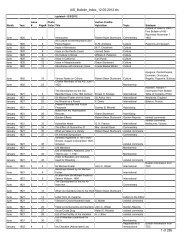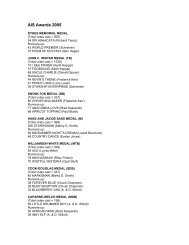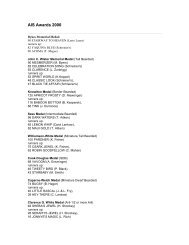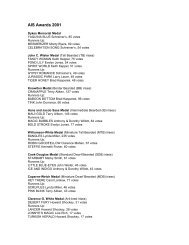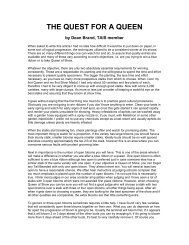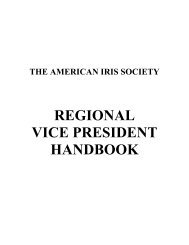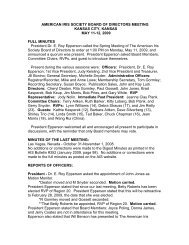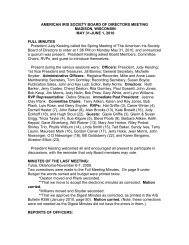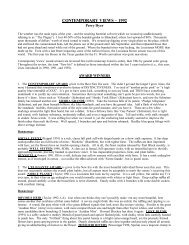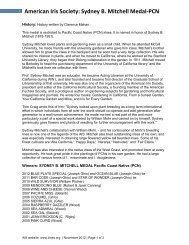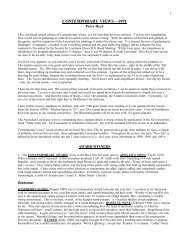contemporary views – 1988 award winners - American Iris Society
contemporary views – 1988 award winners - American Iris Society
contemporary views – 1988 award winners - American Iris Society
You also want an ePaper? Increase the reach of your titles
YUMPU automatically turns print PDFs into web optimized ePapers that Google loves.
harmonious look. The whole flower was highlighted with a luster and class that its parent, ‘Mystique’ (Ghio) frankly<br />
never had. Moderately sized flowers were carried on rather high-branched stalks, at least in the master convention planting<br />
at OSU Tech, but the stalks were strong<br />
enough to hold up the blossoms. CONGRATULATIONS (Keppel 1983) was producing “cup clumps” everywhere.<br />
Floriferous is an understatement. Also a child of ‘Mystique’, this one is very similar in color but with possibly richer<br />
colors, more ruffles, and definitely more carrying power.<br />
CLASSICS: DREAM LOVER (Tams 1971); CABARET ROYALE (Blyth 1976).<br />
AMOENAS:<br />
Two Paul Black seedlings will be mentioned here: 8580D, a large, leathery blue amoena with almost cream standards<br />
rather than the traditional icy white, and broad falls of light blue with Hinkle texture veins. The colors are united with a<br />
soft yellow beard. [NOTE: This seedling was named SPARKLING FOUNTAIN and introduced in 1989]. 851A is one<br />
of the cleanest and brightest of pink amoenas from ‘Infinite Grace’ (Hamblen). Flower form is also an improvement. Tall,<br />
graceful stalks are still somewhat weak, as its parent’s, and may require staking in established clumps. Nonetheless, a<br />
worthy improvement in a color pattern that is most difficult to work with. [NOTE: This seedling was named GIRL<br />
NEXT DOOR and introduced in 1990].<br />
CLASSICS: MARGARITA (Schreiner 1968); GAY PARASOL (Schreiner 1974); RUFFLED BALLET (Roderick<br />
1975).<br />
BICOLORS:<br />
EDITH WOLFORD (Hager 1986) is the most beautiful, elegant iris on the market, second only to ‘Bubbling Lace’.<br />
What a harmonious combination of colors, with soft delicate light yellow standards and quiet, rippling blue-lavender falls.<br />
The entire flower is perfect in its ruffling and fluting, heavy but not overstated. The falls are quite blue in cool weather or<br />
on cloudy days. It has the plant habits, branching, and bud count to back up its beauty. It is so rare when literally<br />
everything comes together in an iris, even though there are hundreds (thousands?) of fine, worthy varieties on the market.<br />
LATIN HIDEAWAY (Nichols 1986) is a color breakthrough, in that it is the best attempt in many decades at a red<br />
amoena. The color of the standards is inconsistent, from a reasonable attempt at white to a smoky lavender-gray, but the<br />
falls are always a beautiful blend of changeable taffeta in reds, lilacs, browns, lavenders, and golds, with the predominant<br />
color being an oxblood to russet red. Incredibly smooth at the hafts, especially considering its background. It has decent<br />
form, above average substance, and is among the most vigorous of any Tall Bearded of recent years. That it won the<br />
President’s Cup by a landslide was really no surprise at all, but what most don’t realize is that it was better last year!<br />
PLANNED TREASURE (Burger 1985) is a true color break, in that it is the first of its kind in this color pattern: Pretty<br />
pink standards and falls, then washed only on the edges of the falls in lavender. It never fails, a color break usually has<br />
some major defect plaguing it, be it poor growth, crazy stalks, 3 buds, whatever. Not so with ‘Planned Treasure’….<br />
WINIFRED ROSS (Hamblen <strong>1988</strong>) was one of the last to bloom, carrying on the tradition in color pattern and stalks of<br />
‘Rosabelle V’ (Hamblen), but with each of its parts (standards, falls, and beards) one to two tones deeper and richer in<br />
color. George Shoop is surely the godfather of new color combinations, and 2 varieties were especially worthy.<br />
HAWAIIAN QUEEN (1986) has medium purple-brown standards and yellow-orange falls, accented with a coral-red<br />
beard. The whole affair may sound gaudy, but there’s something (perhaps the pink heritage) that unites the colors and<br />
makes them pleasing to the eye. ‘Hawaiian Queen’ had noticeably better growth habits than many from this bloodline.<br />
Seedling 8210, seen at OSU Tech, was a broader, more elegant ‘Hula Girl’ (Shoop), i.e., lavender-purple standards and<br />
peach-pink falls) with 2 branches plus spur and decent growth. [NOTE: This seedling was named SPRING TIDINGS,<br />
introduced in 1989].<br />
CLASSICS: CAMELOT ROSE (Tompkins 1965); TOUCHE (Hamblen 1969); LATIN LOVER (Shoop 1969).<br />
POTPOURRI:<br />
A mixed bag of colors and patterns that don’t really fit in any of the color groups above. FANCY TALES (Shoop 1980)<br />
is still wow-ing them! The craziest iris in the world, and unfortunately one of the most finicky. I’m getting it one more<br />
time to grow. Pure white standards. Falls split 50-50, with the top half a bright orange and the bottom half a grapepurple.<br />
Confused? Add fuel to the fire with a thick bushy tangerine beard. I love it! GLITZ ‘N’ GLITTER (Black<br />
<strong>1988</strong>) isn’t quite as wild, but I think it tried. A color break, with medium yellow standards and pansy to plum-purple<br />
falls with a zonal area in the heart of the falls of the standards’ yellow color. Tan edge on the falls helps unite the colors.<br />
10



